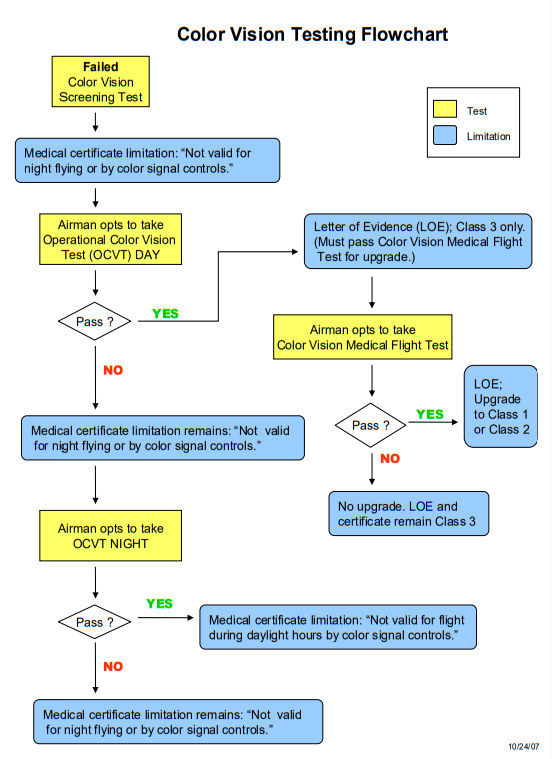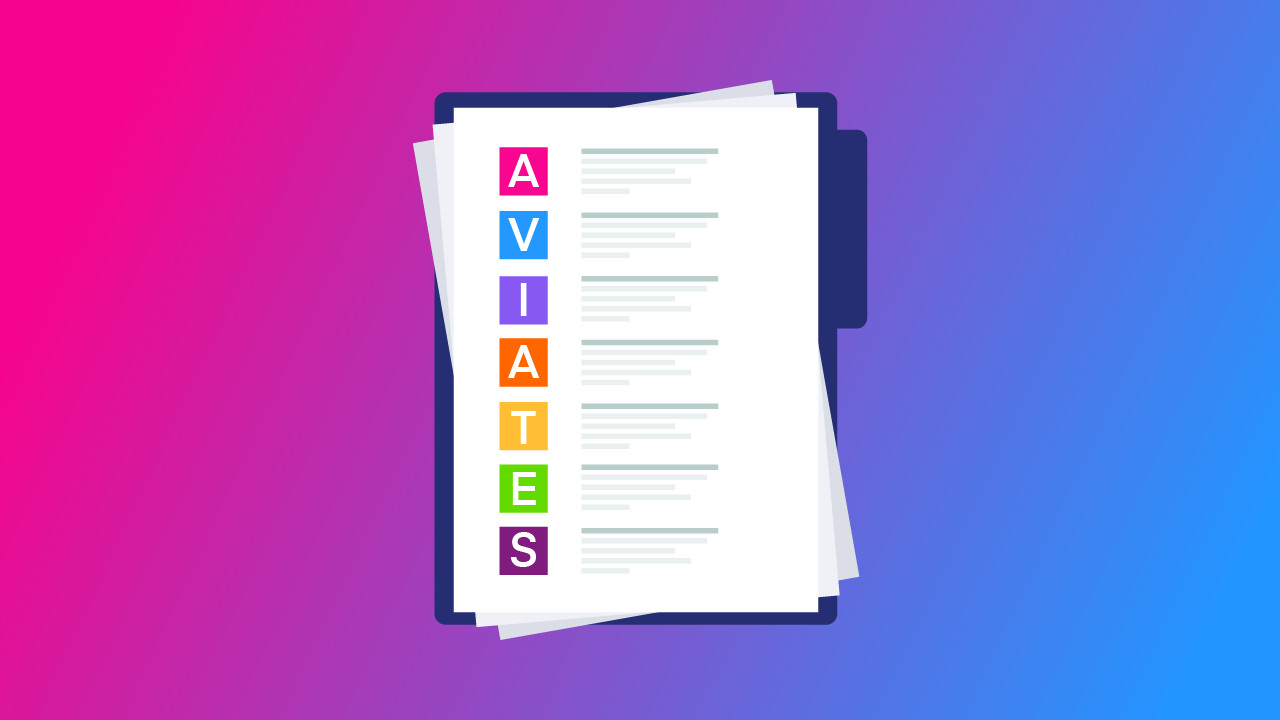-
How Does Color Vision Work?
- The Cones
- Wavelengths
-
What is Color Blindness?
-
What Causes Color Blindness?
- Inherited Color Blindness
- Acquired Color Blindness
- Types of Color Blindness
- Red-Green Color Blindness
- Blue-Yellow Color Blindness
-
Why is Color Vision Important?
- Color Vision in Aviation
-
Color Vision Testing
- Obtaining a Medical Certificate
- Removing The Color Vision Restriction
- Operational Color Vision Test (OCVT) DAY
- Operational Color Vision Test (OCVT) NIGHT
- Color Vision Medical Flight Test (MFT)
- Aeromedical Tourism
-
A Step-by-Step Guide to Removing Your Color Vision Restriction
- Step 1
- Step 2
- Step 2.5
- Step 3
-
Correcting Color Vision Issues
-
The Future of Color-Blind Aviators
-
Conclusion
Approximately 1 in 12 men and 1 in 200 women have issues with color perception. Historically, even those with slight color vision impairment were denied the opportunity to fly.
With advancements in color vision testing, times have changed. It is possible to obtain a pilot license while color-blind and even become an airline pilot, depending on the degree of color vision impairment.
To understand the process of becoming a color-blind aviator, we must examine the importance of color vision and why color blindness is not a one-size-fits-all condition.
How Does Color Vision Work?
Your eyes contain two distinct types of sensory cells:
- Rods
- Cones
The rods are essential for night vision and are sensitive to changes in brightness.
The cells that provide color perception are the cones, and they are the key to understanding the color vision and color vision deficiencies.
The Cones
The cones are found in three different types, each responsible for the perception of different wavelengths:
- Blue Light – S-Cones: Known as “short-cones,” they react to shorter wavelengths.
- Green Light – M-Cones: Following the same naming convention, these cones react to medium wavelengths.
- Red Light – L-Cones: These cones react to longer wavelengths.
Molecules in the cones, known as photopigments, are responsible for converting light into chemical signals.
Wavelengths
Different surfaces reflect different wavelengths. For example, if a surface only reflects short wavelengths, the surface will be perceived as blue by the brain through the s-cones. Colors between blue, green, and red are merely a mixture of different wavelengths being reflected off of a surface. If all wavelengths are reflected simultaneously, your brain will perceive the color white.
Surfaces do not only reflect wavelengths, they also absorb them, which changes the perceived color. Perceived color depends, therefore, on the strength and mixture of light wavelengths reflected and absorbed by a surface.
What is Color Blindness?
Color blindness, often referred to as Color Vision Deficiency (CVD) is a decreased ability to perceive and distinguish between colors. This occurs due to faulty photopigments in the cones.
The degree and type of color blindness depend on which cones and their associated photopigments are faulty.
Deuteranomaly is the most common type of color blindness and affects 5% of males. This color deficiency is due to faulty photopigments in the m-cones, responsible for a green light. With this color vision deficiency, yellow and green appear redder, and distinguishing blue from violet is difficult.
Issues regarding color blindness are generally minor despite no available cure. Achromatopsia, also known as total color blindness, is far rarer, with an estimated 1 in 30,000 individuals affected.
What Causes Color Blindness?
Color deficiencies are classified based on two different causes:
- Inherited
- Acquired
Inherited Color Blindness
Inherited color blindness is present from birth and is the most common cause of color vision deficiency.
Inherited color blindness is genetic and is most often caused by mutated or missing genes affecting the photopigments in the cones. As our understanding of the human genome advances, mutations that cause color-blindness that does not affect photopsin (photoreceptor) genes have been discovered. Our understanding of the genetics behind color vision deficiency is continuing to evolve.
Most inherited color vision deficiencies do not develop or worsen over time and often materialize from birth or early childhood.
Acquired Color Blindness
Acquired color blindness can be acute (short-term) or, less commonly, chronic (long-term).
Acquired color blindness is generally caused by physical trauma to the eye or degenerative diseases. Color deficiency can also be caused by specific prescription drug medication.
While it is certainly possible to obtain a pilot certificate with acquired color blindness, you will likely have to undergo additional medical testing to establish the extent of your color deficiency and whether it is likely to worsen in the future.
Types of Color Blindness
While red-green color vision deficiency is the most common, there are many other types of color vision deficiency.
Color vision deficiency can be classified as follows:
- Red-Green Color Blindness
- Blue-Yellow Color Blindness
Red-Green Color Blindness
There are four types of red-green color blindness:
- Deuteranomaly:
- This is the most prevalent type of color vision deficiency. Deuteranomaly causes green to appear redder. This color blindness is often mild and does not generally interfere with everyday activities.
- Protanomaly:
- This type of color vision deficiency makes red appear darker and greener. This type is also mild and does not generally interfere with everyday activities.
- Protanopia and deuteranopia:
- A more severe version of red-green blindness, protanopia, and deuteranopia is a type of color vision deficiency that causes an individual to be unable to tell the difference between red and green.
Blue-Yellow Color Blindness
Blue-yellow color vision deficiency is less common. This type of color blindness makes it challenging to distinguish between blue and green and between yellow and red.
There are two types of blue-yellow color blindness:
- Tritanomaly:
- Makes it challenging to distinguish between blue and green and between yellow and red.
- Tritanopia:
- Makes it challenging to distinguish between blue and green, purple and red, and yellow and pink. Tritanopia also makes colors appear less bright.
Why is Color Vision Important?
We have so far established that color blindness comes in many forms, with varying degrees of severity. Most people with color vision deficiencies do not need to make any significant changes to their lifestyle, and their color blindness does not affect their day-to-day lives.
Why, then, is color vision considered crucial in aviation?
Color Vision in Aviation
Aviation is full of color-coded symbology, lights, and documentation.
Color is used to decode signals, receive visual cues at airports, and gather information from flight displays, among other things.
Color vision becomes particularly important at night when different colored lights often replace their white-labeled counterparts.
A few of the tasks that require aviators to distinguish between colors include:
- Reading instrumentation.
- Reading warning lights in the cockpit.
- Identifying aircraft at night, particularly regarding position and direction of travel.
- Identification of runway lights at night.
- Reading color-coded documentation and checklists.
Color Vision Testing
FAR Part 67 states that to obtain a medical certificate, applicants must have “… the ability to perceive those colors necessary for the safe performance of airman duties.” This statement appears vague, and you’d be forgiven for not understanding what the FAA means by “perceive those colors necessary for the safe performance of airman duties.”
The truth is, as color vision testing has advanced, the FAA’s definition of “those colors” has changed.
To understand the specific color vision abilities that you will require to obtain certain medical certificates, we need to understand the FAA’s color vision testing standards.
Obtaining a Medical Certificate
When undergoing the exam for your medical certificate, the Aviation Medical Examiner (AME) (a doctor specializing in aviation medicine) will perform a pseudoisochromatic color plate test.
A pseudoisochromatic color plate test, such as the “Ishihara” test, consists of several dots of a specific color that denote a number, with several other dots of a different color surrounding them. If you are able to read the number, you should be able to distinguish between the two associated color spectrums.
If you fail this initial test, all is not lost. You will still be able to obtain a medical certificate, but you will not be allowed to fly at night. The FAA defines this restriction as “no night flying or color signal control.” You will also not be able to obtain a Class 1 or Class 2 medical certificate required for a Commercial Pilot License (CPL).
If you would like to have the restriction removed, you will have to undergo additional testing.
Removing The Color Vision Restriction
This is where things become tricky. The FAA has four additional color vision tests (not including the initial test at the AME’s office) that you can take to remove color vision medical certificate restrictions.
The four exams are the following:
- An FAA-approved alternate color plate test, such as the:
- AOC (1965 edition)
- AOC-HRR (second edition)
- Dvorine
- Richmond (1983 edition)
- Richmond-HRR
- Operational Color Vision Test (OCVT) DAY
- Operational Color Vision Test (OCVT) NIGHT
- Color Vision Medical Flight Test
The alternate pseudoisochromatic color plates are less sensitive to mild color vision deficiency. If you pass the alternate color vision plate test, you’re good to go – all restrictions have been removed. You will, however, have to retake the alternate color vision plate test every time you renew your medical certificate.
If you do not pass the alternate test and would like the restrictions removed, you will have to undergo more detailed testing.
The FAA provides this color vision testing flowchart

to visualize the various ways you can remove color vision restrictions.
Here is the summary:
- If you want to obtain a Class 1 or Class 2 medical certificate (which is required to obtain a Commercial Pilot License), you need to pass the:
- Operational Color Vision Test (OCVT) DAY, and the;
- Color Vision Medical Flight Test.
- If you want to obtain a Class 3 medical certificate (required for a Private Pilot License) and fly at night, you need to pass the:
- Operational Color Vision Test (OCVT) DAY, or the;
- Operational Color Vision Test (OCVT) NIGHT.
So, what are these exams, and how does one pass them?
Operational Color Vision Test (OCVT) DAY
The OCVT consists of two components:
- A signal light test, which will take place at an Air Traffic Control (ATC) tower; and
- A reading test, during which you will be required to identify colors on an aeronautical chart.
If you fail the OCVT DAY, you still have an opportunity to have the night flying restriction removed by undergoing the OCVT NIGHT, but you will not be able to obtain a Class 1 or Class 2 medical certificate required for a Commercial Pilot License.
You only have one chance to pass the OCVT, so it is critical that you practice beforehand.
To pass the OCVT, consider contacting an Air Traffic Control tower and request permission to practice reading the signals from a light gun. Furthermore, ask an instructor to go through an aeronautical chart and ask you questions relating to color symbology on the chart.
By practicing the test, you will get a chance to identify colors as you perceive them and make note of the differences between colors that may appear similar to you.
Operational Color Vision Test (OCVT) NIGHT
If you fail the OCVT DAY, you will have the option to retake the test at night.
The OCVT is easier to pass during the night, as the colors of the light signals are brighter and may be easier to distinguish between.
If you pass the OCVT NIGHT, you will be able to fly at night, and your license will only have the restriction of “Not valid for flight during daylight hours by color signal controls.”
Color Vision Medical Flight Test (MFT)
To remove all restrictions and obtain a Class 2 or Class 1 medical certificate, you must pass the OCVT DAY and the Color Vision Medical Flight Test.
The Color Vision Medical Flight Test (MFT) is an actual flight test with a flight instructor. During the MFT, the flight instructor will ask various questions relating to the following:
- Instruments and displays.
- Terrain and obstructions, particularly regarding emergency landing fields.
- Aeronautical lights such as:
- Colored aircraft lights.
- Runway lights.
- Airport lights.
- Obstruction lighting (such as red lights on high buildings and towers)
The flight instructor is unlikely to ask you to perform specific exercises such as turns or stalls, and the flight will be comparable to a scenic flight. Additionally, the examiner (flight instructor) may request that you rent an aircraft with G1000 or equivalent instrumentation. The G1000 is an Electronic Flight Information System (EFIS) and displays various colors. If you can read and identify the colors on a G1000, you will have no trouble piloting an aircraft.
If you pass the Operational Color Vision Test (OCVT) and the Color Vision Medical Flight Test (MFT), the examiner will issue a Letter of Evidence (LOE) that removes any color vision restrictions for all classes of medical certificates.
Aeromedical Tourism
An unfortunate trend has developed due to outdated testing standards for color vision deficiencies. Some pilots who fail to obtain a medical certificate due to color vision issues attempt to obtain medical certification in a different country and then convert their license back to their initial intended country. This is commonly known as “aeromedical tourism.”
This is due to different color vision testing standards across the world, even among ICAO license member states. ICAO provides no guidance on how member states should determine a passing threshold for color vision tests.
This practice is less common among FAA license holders but is more common in the rest of the world, where ICAO licenses are more easily converted.
Aeromedical tourism can be very expensive and is morally questionable, but it is a solution for individuals who are not fully color-blind.
A Step-by-Step Guide to Removing Your Color Vision Restriction
With all of these different tests, restrictions, and classes of medical certificates, you would be forgiven for being a little confused.
Luckily, we’re here to help. Here is a step-by-step guide on removing color vision restrictions on your medical certificate.
Step 1
If you fail the initial pseudoisochromatic color plate test, you can opt to take an FAA-approved alternative color plate test. You can reference this document from the FAA for a list of acceptable test instruments and their pass criteria.
The Aviation Medical Examiner (AME) that administered your initial color plate test should be able to assist you with the scheduling of an alternative color plate test.
If you decide not to undertake or fail the alternate color plate test, you will only be able to obtain a Class 3 medical certificate, and you will not be allowed to fly at night.
Step 2
If you fail the alternate color plate test as well, you will need to undergo the Operational Color Vision (OCVT) DAY test administered by an FAA aviation safety inspector.
This test will need to be scheduled through your local FAA Flight Standards District Office (FSDO). To find your nearest FSDO, visit this link.
You only have one chance to pass the OCVT, and you may therefore want to prepare by reviewing VFR sectional charts and related aeronautical lighting and airport visual aids.
It is also highly recommended that you contact your local towered airport and ask if they can demonstrate the signal light system. This will allow you to see and practice identifying the signal light colors. Large commercial airport towers will likely not be able to assist you as they are generally too busy.
If you fail the OCVT DAY, you will unfortunately not be able to obtain a Class 1 or Class 2 medical certificate required for a Commercial Pilot License. However, you still have a chance of removing your night-flying restriction.
Step 2.5
The FAA examiner that performed your OCVT DAY will inform you if you have passed and should also be able to assist you with scheduling the OCVT NIGHT. At this point, the OCVT NIGHT is your only way of removing your night-flying restriction.
Step 3
If you pass the OCVT DAY, you will not have to undergo the OCVT NIGHT, but you will have to undergo the Color Vision Medical Flight Test (MFT). The MFT is also scheduled through your local FSDO office, but you will have to rent an airplane yourself. When contacting the FSDO, be sure to ask them if there is a specific type of aircraft that you should rent, what time of day the flight should be, and if there are any other requirements that need to be satisfied.
Correcting Color Vision Issues
Color vision deficiency has no known cure as of yet. Instruments such as “color correcting glasses” have been developed that filter and block out specific wavelengths, allowing individuals with more common color blindness to have greater color perception.
The efficacy of color vision correcting glasses varies significantly between individuals, and they are not FAA approved. This means that you cannot wear them when undergoing a color vision test.
The Future of Color-Blind Aviators
It is inevitable that as color vision testing improves, more color vision deficient individuals will be able to receive Class 1 and Class 2 medical certificates.
Because of the variable and individual nature of color vision deficiency, it is challenging to create an objective pass/fail criteria. This is bound to change in the future. When more accurate and specific color vision testing is developed, strict but fair standards will be developed based upon the results of the accurate color vision deficiency test.
The FAA will be able to adjust testing pass criteria to filter out individuals with specific types and severities of color vision deficiency. With approximately 8% of males experiencing some kind of color vision deficiency, it is imperative that the FAA allow as many individuals as possible to qualify and become aviators as demand continues to grow.
Conclusion
For a detailed overview of the medical testing procedures for color vision used by the FAA, see this document
Here are example videos of the signal light in action:



